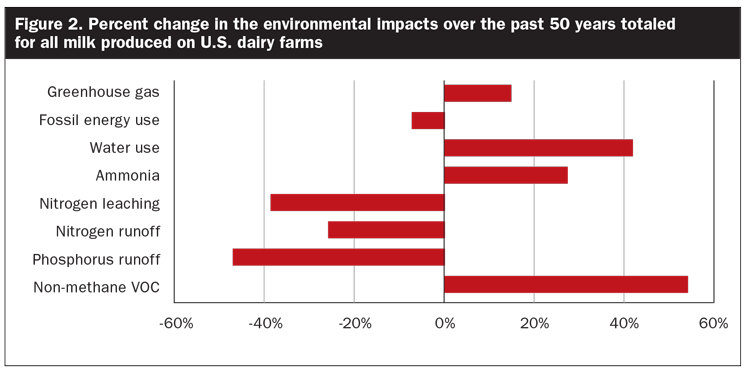
Many aspects of dairy farming in the U.S. have changed over the past 50 years. Milk production efficiency has risen greatly with about 30% fewer cows producing about twice the amount of milk today. Other improvements include increases in crop yields, fuel efficiency of farm equipment, and efficiency in producing most resources used on farms such as electricity, fuel, and fertilizer.
These improvements have led to changes in the overall environmental impact of farms. We hear much about the environmental problems associated with dairy farms; we need to give more credit to the progress being made.
It is not possible to know the environmental impacts of our farms 50 years ago; we cannot go back in time and take measurements. Even for our farms today, it is not possible to measure all the various influences a farm has on our environment. Through farm modeling, though, we can take a look back in time as well as conduct a more comprehensive review of our farms today.
We modeled dairy farms across the U.S. using the performance and management of 1971 and 2020. From these computer simulated farms, we obtained information on nutrient losses, greenhouse gas (GHG) emissions, fossil energy use, water use, and a few other categories.
Efficiency and the environment
One approach to measuring the environmental impact of our farms is to determine and compare improvements expressed per unit of milk produced. This is the approach that most studies have used. This is an important approach as we need to produce more food while caring for our planet.
For all environmental categories we studied, impacts expressed per unit of milk produced were reduced (Figure 1). We found that our farms today are emitting 42% less GHG and using 54% less fossil energy and 28% less water to produce a gallon of milk. In addition, nitrogen and phosphorous losses per gallon have been reduced.

These improvements have primarily come by producing more milk while feeding and maintaining fewer cows. We estimate that about 40% less feed dry matter is consumed today to produce a gallon of milk. Considering this improvement in efficiency, we find all dairy animals today are consuming about the same amount of forage that was consumed on dairy farms in the early 1970s. Grain and by-product feed use has increased, though, creating a 14% rise in total feed consumed.
Production and the environment
It is also important to consider the total environmental impacts across all dairy farms and milk produced in the U.S. A major change that has occurred over this period is the shift in milk production from the more humid eastern part of the country to the relatively dry Western regions. Cow numbers in the East have declined by 49% while doubling in the West. This shift has created both positive and negative effects on the environment.
Over all milk produced, GHG emissions associated with dairy farms have grown about 14% (Figure 2). This is an increase, but a relatively small one when we consider how much more food is being produced. Fossil fuel energy use in milk production has not changed much. More efficient production of electricity, more efficient diesel engine use, and greater use of anaerobic digesters to produce energy have offset the need for more energy.

Nitrogen is lost from our farms through many pathways, including ammonia volatilization, leaching to ground water, surface runoff, and denitrification processes in stored manure and soil. Total ammonia emissions from all U.S. dairy farms has climbed over this period due to greater use of long-term manure storage and open lot housing.
Leaching and runoff losses show major reductions through more efficient fertilizer use and growing use of reduced tillage and cover crops, particularly in the Eastern regions. Expansion of dairy in the drier western regions has also helped reduce these losses. Large reductions in phosphorus runoff were also found for the same reasons. Little change was found in nitrous oxide emissions through nitrification and denitrification processes in the manure and soil, so this source of GHG has been relatively stable.
Volatile organic compounds (VOC) are primarily emitted from silage and manure. The release of these compounds is a problem when they react in the atmosphere, creating smog, which can be a concern in some locations. Our simulations indicate that VOC emissions from all dairy farms rose by 53% over this period due to greater use of long-term manure storage and silage stored in large bunkers and piles.
Methane is also a VOC, but we viewed it separately as a GHG. Cattle and the manure they produce are major sources of methane. We found that methane rose by 32%, which was a major contributor to the overall increase in GHG emissions.
The challenge of water
Perhaps the most important concern for the environmental sustainability of dairy farms is that of water use. With the shift in dairy production to the West, dependence upon ground and surface water has grown. Our study indicates that dairy farms today are using 42% more water from these sources than those 50 years ago. This water consumption is almost entirely for irrigated crops used for feed, with less than 5% used for drinking, cleaning, and other uses.
Water use and availability is primarily a concern for dairy production in the West. Higher ambient temperatures and declining precipitation have reduced water availability in many locations. Warmer temperatures and reduced snowfall are also reducing snowpack in the mountains, which has been a major source of irrigation water for some areas. The demand for water along with projections for reduced water availability create a need for strategies to further improve water use efficiency in crop irrigation and other water uses in dairy production.
Much progress has been made in improving production efficiency. Still, continued improvement through new strategies and technologies is needed to meet the growing demand for dairy products while further mitigating the environmental impacts of our farms.


